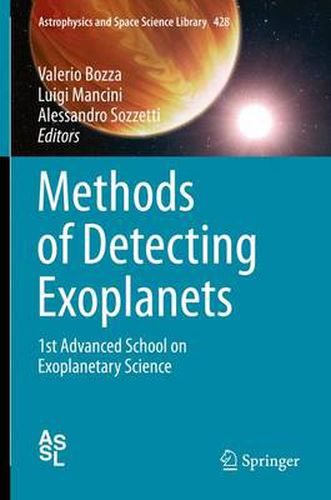Readings Newsletter
Become a Readings Member to make your shopping experience even easier.
Sign in or sign up for free!
You’re not far away from qualifying for FREE standard shipping within Australia
You’ve qualified for FREE standard shipping within Australia
The cart is loading…






This title is printed to order. This book may have been self-published. If so, we cannot guarantee the quality of the content. In the main most books will have gone through the editing process however some may not. We therefore suggest that you be aware of this before ordering this book. If in doubt check either the author or publisher’s details as we are unable to accept any returns unless they are faulty. Please contact us if you have any questions.
In this book, renowned scientists describe the various techniques used to detect and characterize extrasolar planets, or exoplanets, with a view to unveiling the tricks of the trade of planet detection to a wider community. The radial velocity method, transit method, microlensing method, and direct imaging method are all clearly explained, drawing attention to their advantages and limitations and highlighting the complementary roles that they can play in improving the characterization of exoplanets’ physical and orbital properties. By probing the planetary frequency at different distances and in different conditions, these techniques are helping astrophysicists to reconstruct the scenarios of planetary formation and to give robust scientific answers to questions regarding the frequency of potentially habitable worlds. Twenty years have passed since the discovery of a Jupiter-mass companion to a main sequence star other than the Sun, heralding the birth of extrasolar planetary research; this book fully conveys the exciting progress that has been achieved during the intervening period.
$9.00 standard shipping within Australia
FREE standard shipping within Australia for orders over $100.00
Express & International shipping calculated at checkout
This title is printed to order. This book may have been self-published. If so, we cannot guarantee the quality of the content. In the main most books will have gone through the editing process however some may not. We therefore suggest that you be aware of this before ordering this book. If in doubt check either the author or publisher’s details as we are unable to accept any returns unless they are faulty. Please contact us if you have any questions.
In this book, renowned scientists describe the various techniques used to detect and characterize extrasolar planets, or exoplanets, with a view to unveiling the tricks of the trade of planet detection to a wider community. The radial velocity method, transit method, microlensing method, and direct imaging method are all clearly explained, drawing attention to their advantages and limitations and highlighting the complementary roles that they can play in improving the characterization of exoplanets’ physical and orbital properties. By probing the planetary frequency at different distances and in different conditions, these techniques are helping astrophysicists to reconstruct the scenarios of planetary formation and to give robust scientific answers to questions regarding the frequency of potentially habitable worlds. Twenty years have passed since the discovery of a Jupiter-mass companion to a main sequence star other than the Sun, heralding the birth of extrasolar planetary research; this book fully conveys the exciting progress that has been achieved during the intervening period.